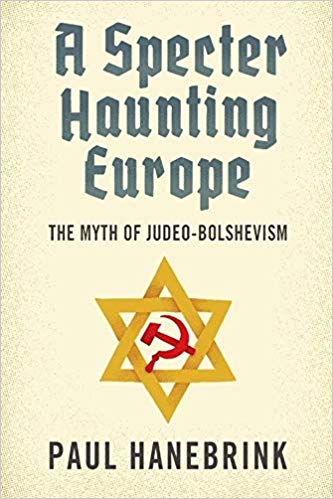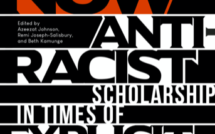

The question that Paul Hanebrink tackles in this fascinating study is of crucial importance for analyzing antisemitic mass violence in the twentieth century. He strives to explain the power and persistence of the myth of Judeo-Bolshevism. What is meant by this myth? It is about the idea that communism was basically created by Jews as an instrument to subject the world to, and prepare it for, a Jewish take-over. According to this view, fighting against communists and fighting against Jews is fundamentally the same battle. At the end of World War I and in its aftermath, the claim that a secret Jewish plot was behind the 1917 Bolshevist October-Revolution spread rapidly. The myth of Jewish Bolshevism figured prominently in the subsequent civil and national wars in the former czarist empire between 1918 and 1921; it played a central role in the short-lived Soviet regimes in Munich and Budapest in 1919. “The Jews” were also allegedly behind the many communist and leftist movements that emerged all over Europe. Identifying Jews with communism is a practice that persisted in interwar Europe. During World War II, it even turned into one of the main rationalizations for murdering European Jewry. After 1945, the myth was still very influential in Eastern Europe, shaping politics and public perception of the communist take-over there. Its influence declined in the 1950s, but reappeared here and there, for example in 1968 in Poland. After the implosion of the Soviet Union, the myth regained public relevance, especially in East European memory politics. Hanebrink tells us the long and complicated story of the people who believed in this idea, used it, and treated it as “real.” He is the first scholar to do this in a comprehensive and inclusive way, covering the entire twentieth century and addressing diverse European societies. He uses an impressive range of contemporary newspapers, writings by intellectuals, and historiographical literature in English, German, French, and Hungarian.
Hanebrink’s study has been praised, and deservedly so, in reviews by eminent historians such as Christopher Browning, Jeffrey Herff, and Ferencz Laszlo.[1] Since he is the first to tackle the topic in this form, it is not surprising that his work would raise some questions and, hopefully, trigger debates. Hanebrink declines to engage in counting how many Jews were communists. He identifies this question as misleading because to answer it one would have to use rigid ethnic categories when there were none. For him, it would bring disproportionate attention towards a single political choice by Jews. Only a tiny minority of Jews became communist. Of those who were politically active, most were bundists, yiddishists, socialists, Zionists, or belonged to religious conservative parties. I would add that, in certain circumstances, the act of “counting Jews among communists” is itself an antisemitic act, because it is based on the assumption of “Jewish conspiracy.” Nevertheless, the falsification of this alleged empirical basis might be useful, because it shows the extent to which the identification of Jews as communists is a cultural antisemitic construct, lacking any real historical basis. The often referred to “kernel of truth”, that some people with Jewish background were partly playing a prominent and visible role among communists, has no link whatsoever to an antisemitic reaction to this interesting phenomenon. One should not expect any change in the world-view of an antisemite through facts. Hanebrink quotes the reaction of a Romanian gendarmerie inspector at the close of an investigation in 1941 that aimed to ascertain how many Jews had served the Soviets. It turned out that in one particular county, only three out of 128 local officials had been Jews. Yet, the Romanian inspector concluded: “The data contradicts the facts”– this man “knew” for a fact that all Jews were Communists (141).
We can only understand the power of this myth if we see it not as a specific form of anticommunism, but as a form of antisemitism in a specific modern context. Based on Shulamit Volkov’s concept of antisemitism as a cultural code, which “explains” for the antisemite the problems of a changing and discomforting world by reducing complexity to a single “Jewish question,” Hanebrink argues that there is no strict distinction between religious and secular forms of antisemitism. “The Jew” often takes the same position as “the devil,” as the“Antichrist.” He convincingly supports his claim that Jews were turned into the main enemies of ethnic nationalists through an analysis of texts emanating from Hungary, Romania and Poland which traces the antisemitic narrative that Jews harm and destroy the nation. Based on this reality, antisemites were seen as defending national culture and sovereignty. In order to understand how this thinking materialized, I would like to remind us of the work by German sociologist Klaus Holz. In his discursive analysis, he brilliantly showed that in a national order of the world it was impossible to define a Jewish position unequivocally.[2]Jews were not really foreigners, and at the same time they were not supposed to be nationals. Contact between Jews across state borders nourished the suspicion that they might constitute something of a unit as “the Jews,” and tend to cosmopolitan theories of socialism or liberalism. All of this combined, predestined Jews to be seen not only as harmful to the build-up of a non-Jewish nation-state, but also as traitors of the nation in a moment of crisis, as well as destroyers of nationhood in a moment of apocalyptic crisis. Having studied the development of antisemitism in Lithuania in the twentieth century, I would argue that this was exactly how perception developed: Jews were allegedly harming the nation, then betraying it, then destroying it.
How does Hanebrink explain the power of the myth? He argues that fears and anxieties triggered by the Bolshevist revolution were crystallized in the figure of the Jewish Bolshevik and that the myth revived old anti-Jewish themes: first disorder, second conspiracy, and third fanaticism. Then the contemporary and ubiquitous discourse made the myth seem real to so many. I question whether referring to old anti-Jewish prejudices and anxieties about the revolution constitutes a sufficient explanation. I would additionally like to learn which groups of people turned into antisemites in such a situation and why. In other words, I would ask whether Hanebrink’s argument is a bit too general and too vague here. While he describes many different forms of anti-Jewish violence during World War I and its aftermath, again the main argument seems too vague: “These attacks on Jewish civilians reflected the persistence of violence in a region where World War I evolved into a series of interlocking regional wars that unfolded against the backdrop of revolution” (58). In the Polish East, “anxieties about the state insecurity fueled the idea of Judeo-Bolshevism and propelled it into the center of Polish national politics” (62). Turning to antisemitic panic at the Romanian Iasi University in 1920, he concludes that the panic, “arose from these broader anxieties” (65). Again: are these phenomena really explained here in a sufficient manner?
One further question: Hanebrink begins his analysis of interwar Europe on the strong note that “Judeo-Bolshevism made Adolf Hitler” (83). Was that the case or would it be more appropriate to argue that “Antisemitism made Hitler?” The latter argument would include a much stronger emphasis of the anti-liberal, anti-western notion of Hitler, which should not be minimized in analyzing his world-view. I think that what Hanebrink tells us about the Romanian fascist Corneliu Codreanu—that Bolshevism and Liberalism were both Jewish plots against the nation—is true for all fascists (3). Antisemitism at the time was seen, at its core, as a conspiracy attacking “organic” true nations from a leftist and a liberal points of view. Hanebrink effectively shows that antisemites construct their world-view in such a way that all negative aspects of modernity are identified as Jewish, negative aspects of communist parties are supposedly Jewish (after 1945), and that negative aspects of our own past are caused by Jews (after 1989). Antisemitism is much more than a set of prejudices, or a distorted expression of fears and anxieties. Likewise, it is something other than racism, even though both share many characteristics. As Deborah Lipstadt has recently reminded us: “The racist punches down, saying that a person or a certain group is lesser than me; the antisemite punches up, saying that, if I don’t protect myself, those powerful Jews will manipulate.”[3]
I am constrained here from discussing in detail my thoughts on Hanebrink’s take on the role of Jewish Bolshevism during World War II and the Shoah. I agree with his argument that “the idea of Judeo-Bolshevism was crucial to the genesis of the Final Solution” (136). However, he tries to do too much here by touching on too many topics. He then analyzes the communist effort after 1945 to legitimize communist rule and finds that it turned nationalist, transforming the function and meaning of the myth of Jewish Bolshevism. Hanebrink thus helps us to better understand the anti-Jewish pogroms that took place after 1945, the concept of transitional justice, and antisemitic notions in the communist show-trials that took place between 1948 and 1953. According to Hanebrink, Judeo-Bolshevism was tabooized in the West after 1945, and was in a way, succeeded by the construct of an anticommunist Judeo-Christian civilization against “asiatic bolshevism.” This part makes sense insofar as Hanebrink concentrates on versions of anticommunism but his topic is actually the history of an antisemitic term.[4] Hanebrink shows how the myth of Jewish Bolshevism shaped memory in Eastern Europe. He strongly argues that nowadays much of the debate is about the fate of liberalism. A liberal civic culture is at stake. National identity politics propagates the nonsense that a civic culture would strip nations of their honor and identity. In the epilogue, Hanebrink claims that the fear of Islamic fundamentalism is the new avatar (282). I would argue instead that Islamist terror is still seen as a weapon of the weak. It needs to be contained and controlled and its harm minimized. In contrast, antisemitism is a world-view, which imagines its Jewish enemy as the most powerful, conspiratory enemy. The continuity of the myth of Jewish Bolshevism lies in powerful variations of antisemitism. “We are fighting an enemy that is different from us. Not open, but hiding; not straightforward, but crafty; not honest, but base; does not believe in working, but speculates with money; does not have its own homeland, but feels it owns the whole world.” These words were said by the prime minister of Hungary, a member state of the European Union, Victor Orban, in his inaugural address in 2018. Aside from his comprehensive analysis of the history of the myth of Jewish Bolshevism in the twentieth century, another most noteworthy aspect of Hanebrink’s work, is the way in which his arguments brilliantly challenge the reader, provoking meaningful and valuable questions.
Christoph Dieckmann (University of Bern) is a historian who taught Modern European History at Keele University in the United Kingdom from 2005 until 2014. Until 2017, he conducted a research project analyzing Yiddish Historiography on the Russian Civil War at the Fritz-Bauer-Institut in Frankfurt am Main. Presently, Dieckmann is working at the University of Bern on a project on sound-history titled “Sounds of Anti-Jewish persecution”; source-wise his focus is on early Jewish postwar-testimonies. His study “Deutsche Besatzungspolitik in Litauen 1941—1944” [German Occupation Policy in Lithuania 1941-1944] was published in 2011 and was awarded the Yad Vashem International Book Prize for Holocaust Research in 2012.
Specter Haunting Europe: The Myth of Judeo-Bolshevism
By Paul Hanebrink
Publisher: The Belknap Press of Harvard University
Hardcover / 368 pages / 2018
ISBN: 9780674047686
[1] Christopher Browning, “The Fake Threat of Jewish Communism“ The New York Review of Books February 21, 2019. Jeffrey Herff, “Review“ Antisemitism Studies 3, no. 1 (Spring 2019): 163-173. Ferencz Laszlo, “Review“ Austrian History Yearbook 50 (2019): 241-243.
[2] Klaus Holz, Nationaler Antisemitismus. Wissenssoziologie einer Weltanschauung (Hamburg: Hamburger Edition, 2001).
[3] Deborah Lipstadt in an interview 15 May 2019: Why Is This Happening? Chris Hayes speaks with historian Deborah Lipstadt about the centuries-old roots of anti-Semitism; (https://briefgate.com/2019/05/17/tracing-the-roots-of-anti-semitism-with-deborah-lipstadt-podcast-transcript/)
[4] Hanebrink deliberated for a long time, whether this chapter should be included or not. See the interesting interview, 24 May 2019: https://srbpodcast.org/2019/05/24/the-judeo-bolshevik-myth/.
Published on January 16, 2020.




